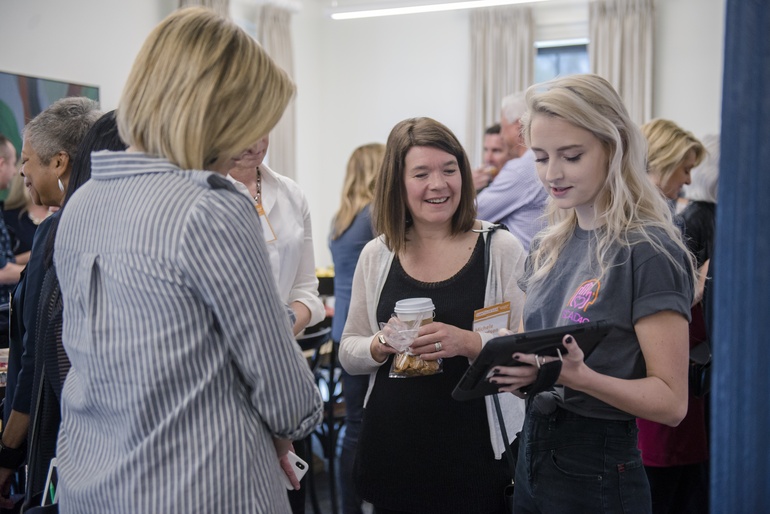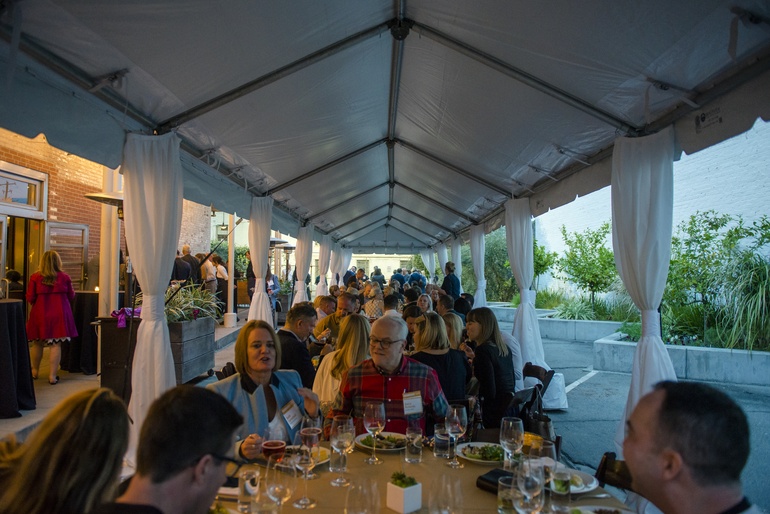Giants of Design 2019 Explores Emerging Industry Trends and Technologies
After Sunday evening’s buzzy networking cocktail hour on day one of Giants, attendees reported to Ruskin Hall at Savannah College of Art and Design (SCAD) bright and early on Monday. Editor-in-chief and Giants host Cindy Allen officially opened the conference with SCAD President and Founder Paula Wallace. Wallace welcomed the Giants to the acclaimed university and introduced the day’s first speaker: Robin Williams, a chair of architectural history at SCAD.
“I’m honored to have been invited to present to you about Savannah’s unique urban environment and the sense of place you find here,” began Williams. He delivered a presentation on Georgia’s unique history—focusing on Savannah during the state’s colonial days, when it was settled and colonized by General James Oglethorpe who named the land in homage to England’s King George II.
“There was this idea from Oglethorpe that Savannah would be a colony of equals. Slavery was [initially] banned,” said Williams, before adding, “along with alcohol, lawyers, and Catholics,” eliciting laughter from the room. Williams went on to explain how the democratic nature of Savannah extended to its historic city planning. “Oglethorpe didn’t want there to be a city center,” he said, going on to explain how Oglethorpe used a grid-based system that prevented a singular city center for Savannah.

Harrison Scott Key, SCAD executive dean and a Thurber-prize winning author published in Harper’s and the New York Times, followed Williams’ presentation. Scott Key, a humor writer, kept the Giants on their toes with witty ‘isms’ aplenty. “How am I relevant to Interior Design?” Asked Scott Key. “That’s a great question! You should ask Cindy,” he admitted cheekily, before being drowned out by yet more laughter.
Scott Key went on to deliver an engaging presentation on his latest book, Congratulations, Who are You Again? The book, which he wrote for his SCAD students, breaks down the nebulous concept of success. “The first key is self-awareness. You all have something really weird about you,” he asserted. “What makes you successful is the ability to see that really weird thing for what it is. You find the little freak inside you that obsesses about, I don’t know, the furniture, or color, or how buildings are designed,” he said, greeted by even more laughter. The undertones of Scott Key’s address touched on acknowledging that with a successful career comes choices and sometimes sacrifices—a notion likely familiar to many of the Giants.
After Scott Key’s presentation, Giants took pause for a coffee break in Ruskin Hall’s parlor, where SCAD’s most accomplished interior design students presented their portfolios to the Giants. “It’s a spectacular opportunity to connect with the designers here, said Scot McMaster, an interior design and photography fellow at SCAD. “Not only are we able to introduce what we’re doing to the designers, but they’re also able to see what our world looks like.”

The Giants then reconvened for the final panel of the day, where Cindy introduced Josh Lind of SCADPro. Lind is the Executive Director of Strategic Enterprises for SCADPro, which is a combined innovation, experience, and venture firm that connects industry-leading brands with forward-thinking SCAD students and programming, in addition to providing financial support to alumni-led companies.
Lind introduced two next-gen SCADPro case studies. He welcomed graduating SCAD senior Cody Reppert to the stage to discuss the first case study, focused on 20 students (including Reppert) who worked with Uber to develop a futuristic air-travel concept for long-distance travel. Lind then introduced Caroline Pavlov an equestrian studies student at SCAD, and Cole Fungaroli who worked with Pavlov on a SCADPro project with other students from majors like industrial design to redesign the hard hat for Clayco.
After the students’ debrief, the Giants ended the day’s session for an al fresco lunch in Savannah’s picturesque Forsynth park. An elevated take on a picnic, the menu was served at rustic tables with views of the native Southern Live Oak trees draped with Spanish moss.

Following lunch, Giants embarked on their choice of local activities; options included a walking architectural tour of historic Savannah, tours of local artists’ and makers’ studios, a private tour of the SCAD Museum of Art, and rooftop yoga at the Perry Lane.
“While I’ve been to Savannah before and had the chance to walk through the city, I had never been to the museum,” said Jorge Mateo, an associate principal of workplace design at Atlanta-based firm TVS. “Every time I go to a new city I try to take advantage of opportunities to see the city’s artwork. I always find inspiration in beautiful things,” he said, recounting the tour, adding, “Meeting new people is always inspiring, too.”
The SCAD Museum of Art is a significant local landmark; it is the only remaining antebellum property in the city, according to Storm Janse Van Rensburg, the museum’s head curator who also led the Giants’ private tour.
The Giants then regrouped at the Perry Lane before departing to dinner and cocktails at The Grey, a celebrated restaurant located inside a restored historic Greyhound terminal. A bourbon and cake tasting followed a dinner of Southern comfort food before trolleys shuttled everyone back to the Perry Lane.

The Giants began their final day of the conference at the Perry Lane’s rooftop lounge. Cindy again welcomed the group over breakfast and introduced the day’s first speaker. Michael Chui is parter at robotics firm McKinsey Global Institute. He spoke with the Giants about how the robotics revolution can help mid-to-senior-level management reclaim up to 50 percent of their time through automation.
“We take seriously what might be the potential of these technologies to do the work that people do in the global economy,” he said. “We have a new set of robotics that are designed to work side-by-side with human beings. Those are some of the things that are changing.” To drive his point home, Chui presented McKinsey Group’s research on the potential for automation, which looked at historical employment rates and how previous technological innovations have shaped product development, the workforce, and international GDP growth.
Chui’s research gave the Giants a lot to think about. An audience Q&A followed, where attendees asked about topics like machine learning, sustaining economic growth as workplace population declines, and America’s workplace culture.

Next, Teri Yarbrow, the president and co-founder of Emmy award-winning creative firm Magika introduced the Giants to augmented and virtual reality. The virtual reality concept that resonated most with the group was Microsoft’s newly re-launched HoloLens VR headset, which allows architects to virtually tour their building plans with SketchUp integration.
“We’re on the edge of a paradigm shift, and I truly believe that this is a super exciting time to work be working as a designer, as a creator, and as an artist,” Yarbrow said.
For the final session of Giants, Cindy introduced Amanda Schneider of ThinkLab. Interior Design’s newest partner, ThinkLab is revolutionizing contract interior design through transparent research that facilitates communication between manufacturers and designers.
“We like to say we’re designers who think like researchers and researchers who think like designers. We started this on the contract side, but we are evolving to health and wellness, hospitality, and residential as well. We’re taking some of our grassroots strategies and expanding them. “
After introducing ThinkLab, Schneider opened the floor for a discussion between the Giants about what’s changed in the industry. Designers and manufacturers alike voiced speed to market, sweeping mergers and acquisitions, and design industry disruptors as some of the most dramatic changes they’ve seen. The conversation then shifted to how designers can evolve their processes to consider new tools and developments in the ever-changing landscape.
It was a fitting finale to Giants, allowing the designers and manufacturers to come together and frankly discuss how they’re affected by the industry of design.
> Check out more coverage from Giants of Design 2019
A special thanks to our Giants of Design 2019 sponsors.
































